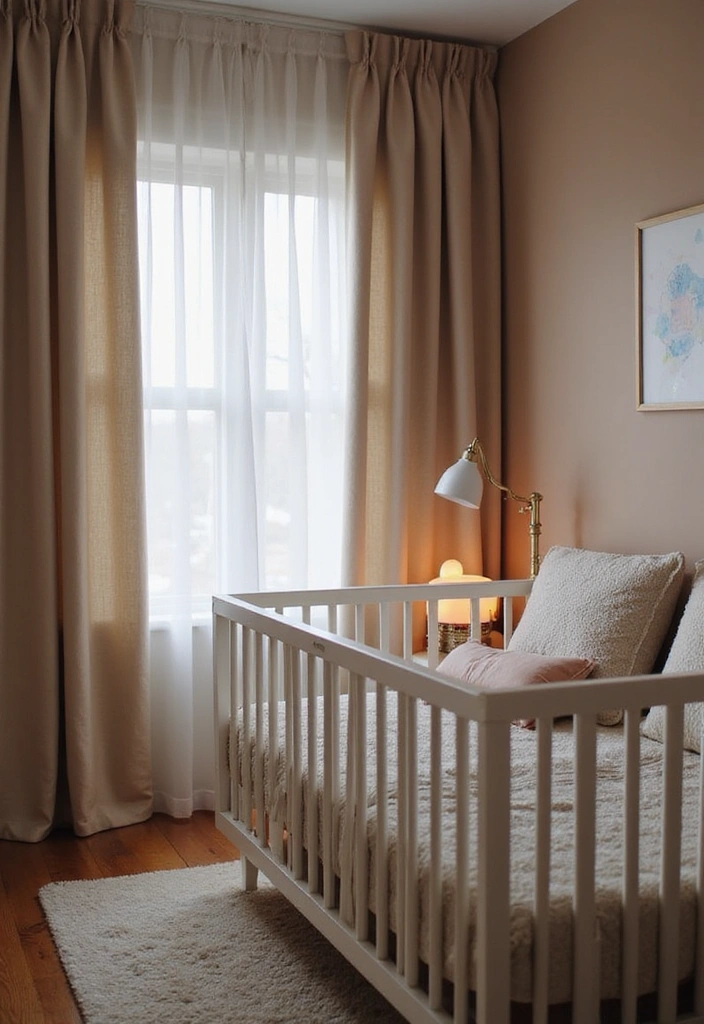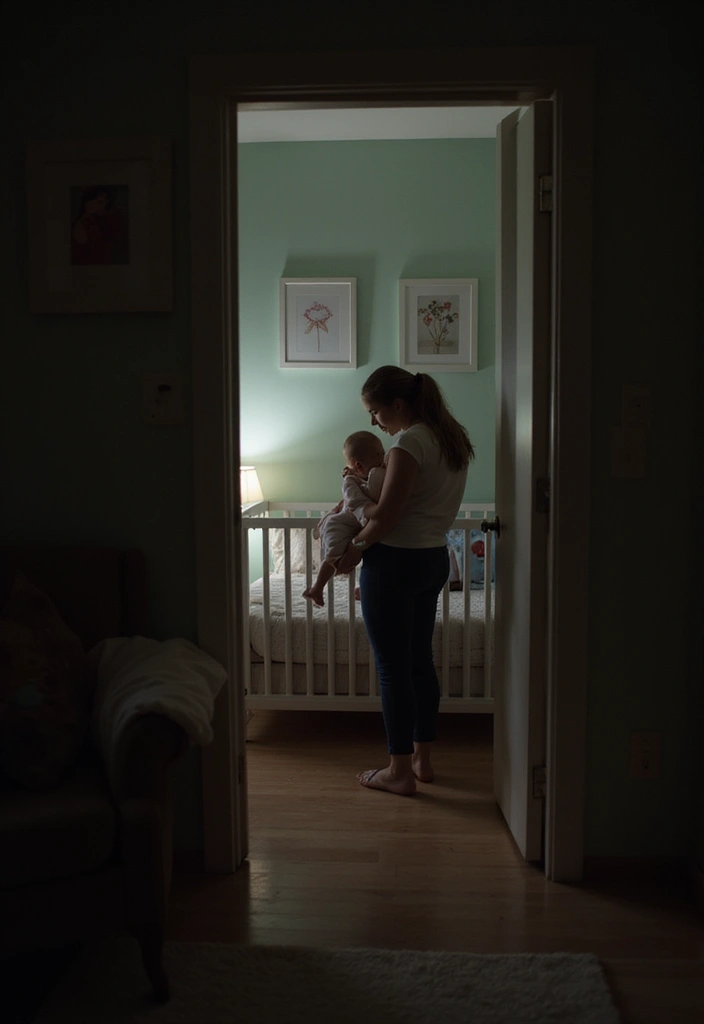17 Game-Changing Baby Sleep Strategies You Need to Know (Especially for Sleep Regression!)

Are sleepless nights starting to feel like a norm in your household?
Sleep regression can be a challenging phase for both babies and parents, often leaving little ones and their caregivers feeling exhausted.
This curated list of game-changing baby sleep strategies is designed to help you navigate these tough times, ensuring peaceful nights and restorative sleep for the whole family. Let’s explore these effective techniques that promise to transform your nighttime routine!
1. Establish a Consistent Bedtime Routine
Creating a consistent bedtime routine is essential for signaling to your baby that it's time to wind down and prepare for sleep.
Start this calming ritual about 30 minutes before bedtime, incorporating soothing activities such as a warm bath in the The First Years Sure Comfort Deluxe Newborn to Toddler Tub. Following the bath, consider giving your baby a gentle massage to further relax them, and then enjoy some quality storytime with a beloved book.
This routine not only helps your baby unwind but also establishes a predictable pattern that they can learn to anticipate, making transitions smoother during sleep regression phases. To enhance the soothing atmosphere, think about adding calming music or white noise, such as the Cloud B Tranquil Turtle for a gentle glow and soothing sounds.
Additionally, the Baby Shusher Sleep Miracle can be a helpful tool in creating a serene environment, making bedtime a more enjoyable experience for both you and your little one.
2. Create a Sleep-Inducing Environment

A tranquil sleep environment plays a crucial role in helping your baby both fall asleep and stay asleep.
To create the ideal setting, make sure the room is dark, quiet, and maintains a comfortable temperature. Consider using Munchkin Nursery Projector and Sound System, which not only projects soothing images but also provides calming sounds that can mask disruptive noises, ensuring a peaceful atmosphere for your little one.
Additionally, blackout curtains can be a real game-changer, effectively blocking out any distracting light that might interfere with your baby's sleep.
For a safe and cozy sleeping space, the Dream On Me 2-in-1 Portable Crib is an excellent choice, allowing you to create a comfortable sanctuary for rest.
Finally, investing in a quality mattress like the Baby Brezza Safe & Sleep Crib Mattress can enhance the overall ambiance with gentle support, ensuring your baby feels secure and relaxed as they drift off to dreamland.
3. Implement Gradual Sleep Training Techniques
Sleep training can be a gentle process, and utilizing gradual techniques can significantly aid your baby in learning to self-soothe.
Methods such as the Ferber method and the chair method are excellent options that enable parents to incrementally increase their distance from the crib. This gradual approach helps your little one develop the ability to fall asleep independently over time.
For more structured guidance, consider resources like the Sleep Sense Program or the Baby Sleep Miracle. Additionally, the 5-2-1 Sleep Training Method Guide offers practical strategies to help navigate sleep challenges.
With patience and consistency, these techniques can make the transition during sleep regressions smoother, fostering healthy sleep habits for the long term. Remember that each baby is unique, so be prepared to tailor your approach based on your child's individual needs.
4. Keep Daytime Naps Consistent

Daytime naps are essential for enhancing your baby's overall sleep quality at night.
By establishing a consistent napping schedule that aligns with your baby's natural sleep cues, you can ensure they receive adequate rest throughout the day. Products like the Fisher-Price Comfort Curve Bouncer are great for helping your little one settle down for a nap comfortably.
It's important to avoid overly long naps or naps that occur too late in the afternoon, as these can disrupt nighttime sleep. A well-rested baby tends to be more easily soothed at night, helping to mitigate the challenges of sleep regression. Consider using the Boppy Original Nursing Pillow for added comfort during feeding or settling routines, or even the innovative Snoo Smart Sleeper to promote healthier sleep habits.
5. Avoid Overstimulation Before Bed
Overstimulation can significantly hinder your baby's ability to relax and settle down for sleep.
In the hour leading up to bedtime, it's essential to create a serene environment by minimizing loud noises, bright lights, and high-energy play. Instead, opt for soothing activities like reading a gentle story or softly singing lullabies.
Consider using products like the VTech Baby Lil' Critters Moosical Beads to engage your baby in a calm and interactive way without overwhelming them.
Additionally, the Halo SleepSack Swaddle can help your little one feel secure and cozy, promoting a peaceful sleep environment.
Finally, the Cloud B Sleep Sheep provides comforting sounds that can further assist in creating a tranquil atmosphere. By incorporating these calming elements, you can help your baby transition more smoothly into sleep, particularly during those challenging periods of sleep regression.
6. Monitor Feeding Schedules
Feeding your baby immediately before bedtime can sometimes result in discomfort, leading to interrupted sleep. To promote a more restful night, it's advisable to complete feedings about 30 minutes to an hour before putting your little one down for sleep.
This strategy can help minimize issues such as gas or reflux, which often contribute to fussiness and wakefulness.
For bottle feeding, consider using Dr. Brown's Options+ Wide Neck Bottles, designed to reduce colic and discomfort. If you're breastfeeding, the Medela Pump In Style Advanced Breast Pump can help you manage your feeding schedule effectively. Additionally, for soothing relief, the Lansinoh TheraPearl 3-in-1 Breast Therapy can be a great addition to your nighttime routine.
Experimenting with the timing of feedings throughout the day can also help you discover what works best for your baby.
7. Use a Comfort Object

Introducing a comfort object, such as a soft blanket or a cuddly stuffed toy, can greatly enhance your baby’s sense of security during sleep. A wonderful choice for a comfort item is the Jellycat Bashful Bunny, known for its gentle texture and appealing design, making it a perfect companion for your little one.
These comforting objects can assist your baby in self-soothing, especially during sleep regressions when they may feel anxious or unsettled. As you consider options, ensure that you select a safe and soft item, like the Munchkin Soft-Tip Infant Spoons, which are also designed for gentle use, or even a fun activity jumper like the Baby Einstein Neighborhood Friends Activity Jumper for playtime comfort.
Gradually encourage your baby to associate these items with comfort and rest during sleep time. This simple addition can significantly ease their transition to sleep, providing the reassurance they need to drift off peacefully.
8. Encourage Independent Sleep Skills
Teaching your baby to develop independent sleep skills is essential, particularly during challenging periods like sleep regression.
One effective method is to place your baby in their crib when they are drowsy but still awake, allowing them to learn how to self-soothe. Consider using a Bamboo Baby Sleep Sack to provide a cozy and secure environment that encourages this practice.
This gentle approach helps your little one recognize their own tiredness and fosters the ability to fall asleep without needing assistance.
As they grow more adept at self-soothing, you might notice fewer nighttime awakenings and smoother transitions back to sleep. For an added soothing touch, try playing some Lullaby Renditions of Popular Songs to create a calming atmosphere, or consider a BabyBjorn Cradle for a safe sleep space that promotes relaxation.
9. Be Patient and Consistent
Patience and consistency are essential when navigating the challenges of sleep regression.
It's important to recognize that fluctuations in sleep patterns are a normal part of development, and it may take some time for your baby to adapt to new sleep strategies.
As you implement various methods, such as those outlined in The No-Cry Sleep Solution or The Sleep Easy Solution, remain steadfast in your routine.
Even if you face setbacks, sticking to your chosen sleep training approach will ultimately lead to more restful nights for both you and your baby. For a comprehensive understanding, consider exploring the Baby Sleep Book: The Complete Guide to a Good Night's Rest for the Whole Family, which offers valuable insights and strategies to support your journey.
10. Embrace Shorter Wake Windows
Understanding your baby’s sleep cycles is essential, especially during periods of sleep regression. As your little one grows, you'll notice that their wake windows become shorter, indicating a need for more frequent naps.
To help monitor your baby’s sleep patterns effectively, consider the Owlet Smart Sock Baby Monitor, which tracks their heart rate and oxygen levels, giving you peace of mind while you focus on their sleep cues.
By recognizing these cues and putting your baby down for a nap before they become overtired, you can prevent crankiness and improve their overall sleep quality. For additional guidance, the Baby Sleep Miracle Program offers valuable insights into establishing healthy sleep habits.
Finally, ensure your baby is cozy during sleep with the soft and breathable Little Sleepies Bamboo Pajamas, which can help create a more restful sleep environment.
11. Stay Calm During Nighttime Wake-Ups

Nighttime disruptions can often be unsettling, but it's crucial to maintain a sense of calm for both you and your baby. When your little one wakes up during the night, approach the situation in a quiet and soothing manner.
Instead of turning on bright lights or engaging in stimulating conversation, consider using a product like the Hatch Rest+ Smart Night Light to provide a gentle glow that can help create a calming atmosphere. Offer gentle reassurances and comfort to your baby, as your tranquil demeanor can help them feel secure and encourage a quicker return to sleep.
If you need to attend to your baby in a portable setting, the Graco Pack 'n Play Playard is an excellent option that allows you to keep them close while maintaining a comfortable environment. Additionally, incorporating engaging toys like the Bright Starts Play Gym during the day can help establish a routine that promotes better nighttime sleep.
12. Explore Different Sleep Positions
The way your baby sleeps can significantly influence their comfort and overall sleep quality. Exploring different sleep positions, such as side-lying or tummy sleeping (when safe and appropriate), can help your little one find a more restful posture.
To enhance comfort, consider using a secure swaddle, which can also help reduce the startle reflex during sleep. Products like the SwaddleMe Transition Suit, the Nested Bean Zen Swaddle, and the Halo SleepSack Swaddle can provide the snugness that promotes better sleep while keeping safety in mind. Always ensure the sleeping environment follows safety guidelines to prevent any risks.
13. Limit Screen Time
Exposure to screens before bedtime can significantly disrupt your baby’s sleep quality. The blue light emitted from devices interferes with melatonin production, making it more challenging for your little one to drift off to sleep.
To foster healthier sleep habits, it’s essential to establish a screen-free period leading up to bedtime. Instead of screens, consider engaging activities that promote relaxation, such as reading. Classic bedtime stories like Goodnight Moon, The Very Hungry Caterpillar, and Love You Forever can create a calming pre-sleep atmosphere.
By choosing these soothing activities, you can help your baby transition into a restful night’s sleep.
14. Provide Daylight Exposure

Natural light exposure during the day is essential for regulating your baby's circadian rhythm.
To help your little one distinguish between day and night, make sure they spend ample time in natural light, particularly in the morning.
You can achieve this by taking outdoor walks with a Baby Carrier Wrap or using a Stroller with Canopy that allows your baby to enjoy the sunshine comfortably.
Additionally, consider sitting by a window during daylight hours or using a Sunshade for Baby Car Seat to protect your baby from harsh rays while still benefiting from natural light.
This consistent exposure can help promote healthier sleep patterns, making it easier for your baby to settle down at night.
15. Seek Support When Needed
Parenting can often feel like an overwhelming journey, particularly during those challenging sleep phases when sleep regression strikes.
It’s crucial to remember that you don’t have to navigate this alone. Seeking support from family, friends, or parenting groups can provide a much-needed sense of community.
Sharing experiences and insights can not only lighten the emotional load but also introduce you to valuable resources. For instance, consider picking up The Baby Sleep Book for expert advice on sleep strategies, or Moms on Call, which offers practical tips for managing sleep issues effectively.
Another great resource is Happiest Baby on the Block, which can help you soothe your baby and create a better sleep environment.
Remember, you’re not alone in this journey, and connecting with others while utilizing these helpful resources can make a significant difference in coping with sleep regression.
16. Maintain a Positive Mindset
A positive mindset can truly revolutionize your approach to the sleep challenges that come with parenting. By focusing on small victories and the progress you make, rather than getting bogged down by the difficulties, you can create a more nurturing atmosphere for both you and your baby.
Consider exploring resources like the Mindfulness for Parents Book, which offers valuable insights on maintaining a healthy mindset. Engaging in calming practices, such as yoga on a comfortable Yoga Mat, can also help alleviate stress and promote relaxation.
Additionally, using an Aromatherapy Diffuser in your baby's room can create a soothing environment, encouraging a sense of peace. Remember, sleep regressions are just temporary phases, and by nurturing a positive mindset, you are not only helping yourself cope but also fostering a tranquil space for your little one.
17. Trust Your Instincts
As a parent, your instincts serve as your most reliable compass in the journey of raising your baby.
Every child is one-of-a-kind, and the sleep strategies that work for one may not be effective for another.
To help navigate this complex landscape, consider resources like The Baby Owner's Manual, which provides practical advice tailored for new parents.
You might also find The Wonder Weeks incredibly insightful, as it outlines various developmental phases that can affect sleep patterns.
And don't forget to check out What to Expect the First Year for comprehensive guidance during those crucial early months.
Trust your intuition and feel free to experiment with different methods until you discover what truly resonates with your family's unique needs.
Conclusion
Navigating sleep regression can be a daunting experience, but with the right strategies, you can reclaim peaceful nights for your family.
By implementing these sleep strategies and remaining patient and persistent, you’ll be better equipped to handle the challenges that come your way.
Embrace this journey, and remember that each stage of your baby’s sleep development brings new opportunities for joy and connection.